说课稿新目标英语八年级上全英文
- 格式:doc
- 大小:34.50 KB
- 文档页数:4

【导语】说课是教学改⾰中涌现出来的新⽣事物,是进⾏教学研究、教学交流和教学探讨的⼀种新的教学研究形式,也是集体备课的进⼀步发展。
以下是®⽆忧考⽹为⼤家精⼼整理的内容,欢迎⼤家阅读。
1.初中⼋年级上册英语说课稿 ⼀、说教材: ﹝说课内容﹞:英语⼋年级107 unit 8 welcome to the unit。
﹝教材分析﹞:学⽣在本学期已学习了A good read Good manners等单元,这些单元都有助于提⾼学⽣个⼈的⽂化修养,⽽这⼀单元则是以环境保护为话题(A green world),要求引导学⽣利⽤⾝边的事例及⽣活习惯的养成,让学⽣也意识到保护环境的重要性,因为我们只有⼀个地球。
﹝教学⽬标﹞: 1、知识与能⼒⽬标:培养学⽣能准确运⽤有关如何保护环境的表达。
2、过程与⽅法⽬标:学⽣能就环保的话题展开⼀些简单讨论。
3、情感态度与价值观⽬标:引导学⽣全⾝⼼投⼊保护环境的意识,爱护环境从我们⾝边的每件⼩事做起。
﹝教学重点与难点﹞: 1、能准确运⽤有关如何保护环境的英语表达。
2、培养学⽣保护环境的.意识。
﹝教学准备﹞: 1、教师准备:搜集⽬前环境恶化的⼀些典型实例、图⽚,⽤数据表明我们的地球已陷⼊危险境地了。
2、学⽣准备:从⽇常⽣活中找了找出保护环境的⼀些做法,如,那些是不⽂明的做法,如何低碳⽣活等。
⼆、说教法与学法特⾊: 抓住Hobby与 Eddie卡通⼈物的对话这个主题,创设情境,以情导航。
引导全班学⽣积极参与这个对话,从⾯引出How to protect Environment、 在学法指导上,我采取是迁移、点拨、反馈等多各种指导⽅法。
三、说教学程序设计: 根据以上教学理念,结合本课的特点,我设计如下的⼏个教学环节: ⼀、情景导⼊,激发情趣。
⼆、合作探究,提⾼能⼒。
三、课堂总结,课后延伸。
四、说板书设计; 它是结合本课的重点,难点,所勾勒出⼀张图表,体现了美观、实⽤。
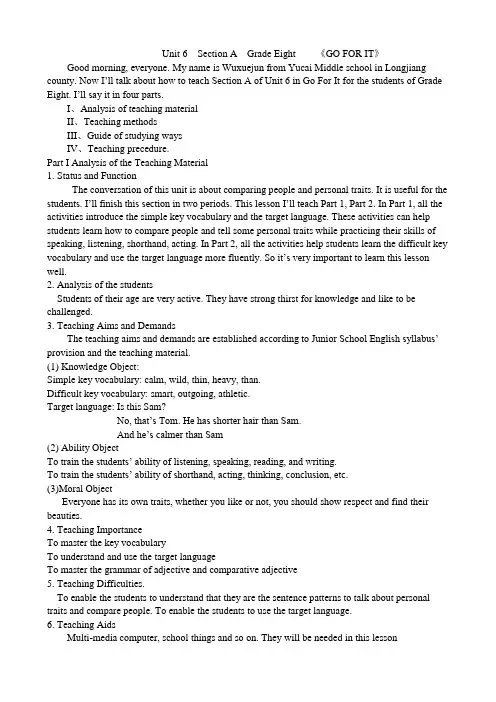
Unit 6 Section A Grade Eight 《GO FOR IT》Good morning, everyone. My name is Wuxuejun from Yucai Middle school in Longjiang county. Now I’ll talk about how to teach Section A of Unit 6 in Go For It for the students of Grade Eight. I’ll say it in four parts.I、Analysis of teaching materialII、Teaching methodsIII、Guide of studying waysIV、Teaching precedure.Part I Analysis of the Teaching Material1. Status and FunctionThe conversation of this unit is about comparing people and personal traits. It is useful for the students. I’ll finish this section in two periods. This lesson I’ll teach Part 1, Part 2. In Part 1, all the activities introduce the simple key vocabulary and the target language. These activities can help students learn how to compare people and tell some personal traits while practicing their skills of speaking, listening, shorthand, acting. In Part 2, all the activities help students learn the difficult key vocabulary and use the target language more fluently. So it’s very important to learn this lesson well.2. Analysis of the studentsStudents of their age are very active. They have strong thirst for knowledge and like to be challenged.3. Teaching Aims and DemandsThe teaching aims and demands are established according to Junior School English syllabus’ provision and the teaching material.(1) Knowledge Object:Simple key vocabulary: calm, wild, thin, heavy, than.Difficult key vocabulary: smart, outgoing, athletic.Target language: Is this Sam?No, that’s Tom. He has shorter hair than Sam.And he’s calmer than Sam(2) Ability ObjectTo train the students’ ability of listening, speaking, reading, and writing.To train the students’ ability of shorthand, acting, thinking, conclusion, etc.(3)Moral ObjectEveryone has its own traits, whether you like or not, you should show respect and find their beauties.4. Teaching ImportanceTo master the key vocabularyTo understand and use the target languageTo master the grammar of adjective and comparative adjective5. Teaching Difficulties.To enable the students to understand that they are the sentence patterns to talk about personal traits and compare people. To enable the students to use the target language.6. Teaching AidsMulti-media computer, school things and so on. They will be needed in this lessonPart II The Teaching Methods1. Communicative teaching method2. Audio-visual teaching method3.”Task-based”teaching methodAs we all know: the main instructional aims of learning English in the Middle School is to cultivate students’ abilities of listening, speaking, reading, writing and their good sense of the English language. So in this lesson I’ll mainly use “Communicative” teaching method,”Audio-visual” teaching method and “Task-base d” teaching method.That is to say, I’ll let the students to get a better understanding of the target language, master the vocabulary and grammar better. I’ll give the students some tasks and arrange several kinds of activities: watching pictures, writing, listening, making conversations, acting, group work and so onTeaching special features: To use these methods is helpful to interest students and develop their thoughts.Part III Studying ways1. Let the students master the key vocabulary better by guessing, acting, listening, using.2. Enable the students study English language by Communicating, Describing, Listening.3. Let the students understand the grammar well by summarizing the grammar rules by themselves. Part IV Teaching ProcedureStep 1 Warm up:Show a picture of Yaoming and a picture of a man, and say Yaoming is taller than him. Then give another picture, let them find the differences. While the student want to express their thought in English ,and they do not have learned the expressions, raise their desire for learning this part of knowledge.(purpose: To attract the student s’ attention and to create a relaxed atmosphere.)Then, show the students the goals :1.We must master the words in section A.2. We can use the adjective and comparative adjective to describe a person.Step2.Check oneLet the studengts do 1a. Practise the target language with long hair and tall. Students are allowed to speak slowly at the first time and a little faster at the second time.This part, I give the student the chance to practice the target language. Improve their speaking skills with comparative adjective.(Purpose: To begin with the review of adjective can enable the students easily master the key points including its regular information and irregular one as well as to learn to make statements by choosing the right adjectives.)Step3. Practice listening 1b—2bListen to the tape, and shorthand the key words. Then, write down the main information in the form of using the target language according to their own shorthand notes. When all have done with the work, I’ll give them the correct answers. And once again I will tell them the skills of shorthand. As shorthand is a useful skill in listening comprehension and modern society, students can learn and practise it from now on.(Purpose: In order to improve students’ listening and writing skills,by playing the recording of the text and repeating,students can further consolidate what they have just learned.)Step4.Performance and communicationDeskmates make a group. Let them act the dialogue with the information in the chart on page 81.Acting makes students understand the meaning of the key vocabulary better and attract the whole class. Making a conversation while some are acting, gives the student the chance to communicate with each other. Repeating the dialogues not only helps the rest of students’ discipline but also makes them practice the target language as well. Grading their own performance is a new way and will make the students try their best to perform well.(Purpose: Through comparison of description of parnter’s appearance and personality can easily arouse students’ learning desire and interests. So they can master difficulties and key points of the text and describe others well.)Step5 ConsolidationDiscuss the two people in the picture. Which one do you like better? why? Then, gradually let them understand we should respect everyone, because every one has its good merits and shortcoming. We should find people’s beauties not only look at their short comings. Good teachers teach not only the students knowledge, but also how to be a man and behave.Write the 3 lists of adjective and comparative adjective are on the blackboard, let one in each group summary the regualaries.It comes to grammar teaching. This part, students are trained to use their own wit to summarize some principles. It is designed to gain points, and students’ wit is cha llenged, so this activity willra ise the students’ interest.Step 6 Check TwoCover the blackboard for 30seconds, and let the students close their eyes and review what they have just learnt. Make a better use of the difficulties and important information on the blackboard. Reviewing at the end of the class can help students’ memory, This part also practice the reading ability and check the pronunciation.Step7 Homework .Make a list of top 10 obvious traits or comparison about your best friend or your parents. When it comes to the homework part, teachers should have enough time to explain their assignment clearly to avoid misunderstanding of demands. At the meantime, the teacher can give students some advice to finish their homework efficiently. Homework which is related to the students’ life can surely trigger their interest to finish the homework earnestly. The homework can help the students to consolidate the target language and train their writing ability.(Purpose: it’s necessary for students to do some extensive exercise after class to consolidate the knowledge they learnt.)Step 8 Blackboard designUnit 6 I’m more outgoing than my sister-er -ier more ~ -Is that Sam?calm-calmer funny-funnier athletic-more athletic -No, that’s Tom, he has shorter hairtall-taller heavy-heavier outgoing-more outgoing than Sam. And he’s calmer than Sam smart-smarter happy-happier interesting-more interestingwild-wilder thin-thinner。
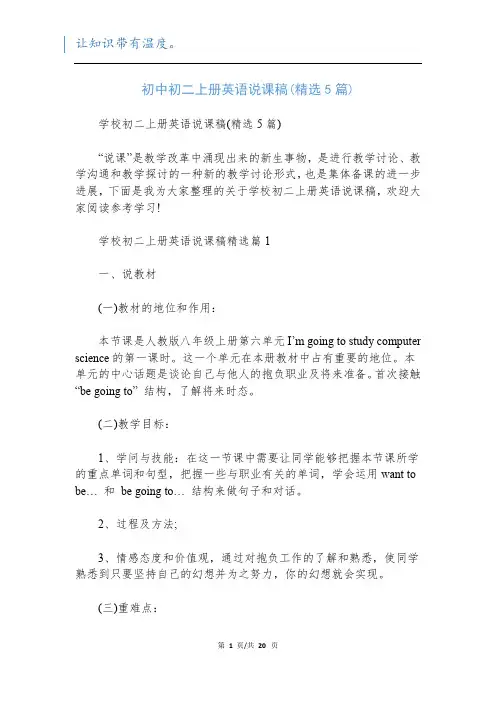
初中初二上册英语说课稿(精选5篇)学校初二上册英语说课稿(精选5篇)“说课”是教学改革中涌现出来的新生事物,是进行教学讨论、教学沟通和教学探讨的一种新的教学讨论形式,也是集体备课的进一步进展,下面是我为大家整理的关于学校初二上册英语说课稿,欢迎大家阅读参考学习!学校初二上册英语说课稿精选篇1一、说教材(一)教材的地位和作用:本节课是人教版八年级上册第六单元I’m going to study computer science的第一课时。
这一个单元在本册教材中占有重要的地位。
本单元的中心话题是谈论自己与他人的抱负职业及将来准备。
首次接触“be going to” 结构,了解将来时态。
(二)教学目标:1、学问与技能:在这一节课中需要让同学能够把握本节课所学的重点单词和句型,把握一些与职业有关的单词,学会运用want to be… 和be going to… 结构来做句子和对话。
2、过程及方法;3、情感态度和价值观,通过对抱负工作的了解和熟悉,使同学熟悉到只要坚持自己的幻想并为之努力,你的幻想就会实现。
(三)重难点:本节课的重难点主要是让同学把握两个短语want to be … 和be going to … 、并能够运用这两个短语进行对话练习。
二、说学情由于本节课的教学对象是八年级的同学,相对于七年级同学有了肯定的英语基础。
在单词记忆和句子把握上有了肯定的方法。
但是为了保证本节课的胜利,还需要先提问那些勇于举手发言和英语水平相对较高的同学们,让其他的同学们能够明白和了解我所提问的内容,并给与他们充分的思索时间和自信念。
三、说教法在本节课中,我将授课、PPT演示与学案相结合,做到精讲,多练。
同时,将自己的角色定位在不仅仅是学问的传授者,同时也是课堂的主导,主要让同学做仆人,提高同学自主学习的力量和小组合作的意识。
四、说学法引导同学通过猜想、观看等方法渐渐感悟新语言项目的功能,让同学在多层次的练习中体会到学习英语时“运用”的必要性,鼓舞同学乐观思维,大胆尝试。
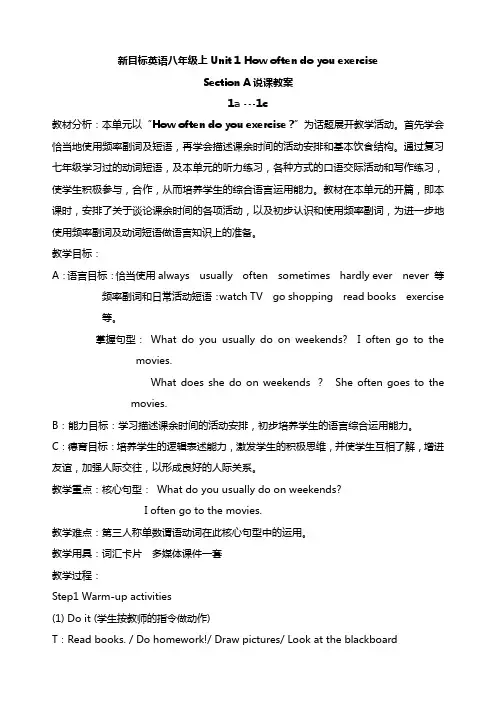
新目标英语八年级上Unit 1 How often do you exerciseSection A说课教案1a ---1c教材分析:本单元以“How often do you exercise ?”为话题展开教学活动。
首先学会恰当地使用频率副词及短语,再学会描述课余时间的活动安排和基本饮食结构。
通过复习七年级学习过的动词短语,及本单元的听力练习,各种方式的口语交际活动和写作练习,使学生积极参与,合作,从而培养学生的综合语言运用能力。
教材在本单元的开篇,即本课时,安排了关于谈论课余时间的各项活动,以及初步认识和使用频率副词,为进一步地使用频率副词及动词短语做语言知识上的准备。
教学目标:A:语言目标:恰当使用always usually often sometimes hardly ever never 等频率副词和日常活动短语:watch TV go shopping read books exercise等。
掌握句型:What do you usually do on weekends? I often go to the movies.What does she do on weekends ?She often goes to the movies.B:能力目标:学习描述课余时间的活动安排,初步培养学生的语言综合运用能力。
C:德育目标:培养学生的逻辑表述能力,激发学生的积极思维,并使学生互相了解,增进友谊,加强人际交往,以形成良好的人际关系。
教学重点:核心句型:What do you usually do on weekends?I often go to the movies.教学难点:第三人称单数谓语动词在此核心句型中的运用。
教学用具:词汇卡片多媒体课件一套教学过程:Step1 Warm-up activities(1) Do it (学生按教师的指令做动作)T:Read books. / Do homework!/ Draw pictures/ Look at the blackboardT: run / stop / stand up / sit down.(2) Do as I do.(学生跟老师边说边做动作)I read books on weekends.I run on weekends.I do my homework on weekends.Step 2 Revision and presentation(1)教师问:“What do you usually do on weekends ? ”(并且板书)让学生根据自己的实际回答I usually ……on weekends.(2)教师出示动词卡片watch TV、read books 、exercise 、clean、skateboard、play basketball、wash clothes、go shopping、go to movies让学生认读。
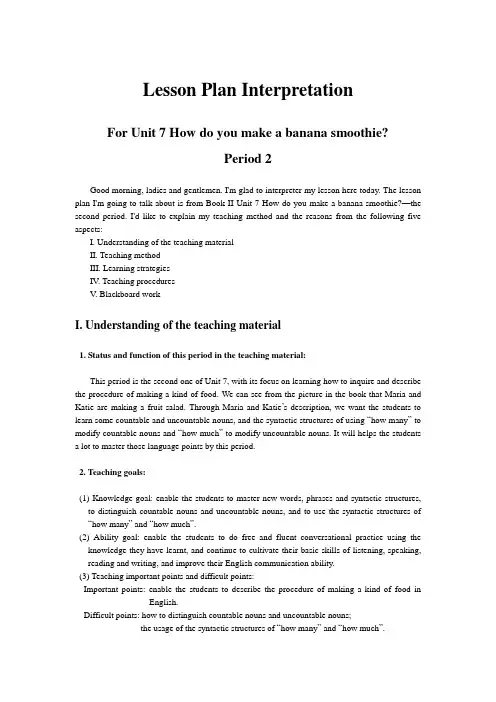
Lesson Plan InterpretationFor Unit 7 How do you make a banana smoothie?Period 2Good morning, ladies and gentlemen. I'm glad to interpreter my lesson here today. The lesson plan I'm going to talk about is from Book II Unit 7 How do you make a banana smoothie?—the second period. I'd like to explain my teaching method and the reasons from the following five aspects:I. Understanding of the teaching materialII. Teaching methodIII. Learning strategiesIV. Teaching proceduresV. Blackboard workI. Understanding of the teaching material1. Status and function of this period in the teaching material:This period is the second one of Unit 7, with its focus on learning how to inquire and describe the procedure of making a kind of food. We can see from the picture in the book that Maria and Katie are making a fruit salad. Through Maria and Katie’s description, we want the students to learn some countable and uncountable nouns, and the syntactic structures of using “how many” to modify countable nouns and “how much” to modify uncountable nouns. It will helps the students a lot to master those language points by this period.2. Teaching goals:(1) Knowledge goal: enable the students to master new words, phrases and syntactic structures,to distinguish countable nouns and uncountable nouns, and to use the syntactic structures of “how many” and “how much”.(2) Ability goal: enable the students to do free and fluent conversational practice using theknowledge they have learnt, and continue to cultivate their basic skills of listening, speaking, reading and writing, and improve their English communication ability.(3) Teaching important points and difficult points:Important points: enable the students to describe the procedure of making a kind of food in English.Difficult points: how to distinguish countable nouns and uncountable nouns;the usage of the syntactic structures of “how many” and “how much”.II. Teaching method:The content of this period is not so much. Besides, I have asked the students to review the new words and the procedure of making a banana smoothie of last period, and meanwhile preview the content of this period to obtain a further understanding of it by drawing pictures and graphs. Thus, the teaching procedures can be more easily carried out.During the course of teaching, I adopt the heuristic method of teaching. For example, when teaching countable and uncountable nouns, I give them some nouns and ask them to point out which are countable and which are uncountable. When teaching the syntactic structures of “how many” and “how much”, because the students can all say sentences like “How many bananas do we need?” and “How much money do we need?”, so I can help them to summarize the points that “how many” is used to modify countable nouns, while “how much” is used to modify uncountable nouns. Because of the preparation they have made before class and their desire to project themselves, they usually can do well. And at this time, the teacher should show her praise and encouragement at once, and then the students will feel happy, which will make them like to learn and be able to learn well. Then, help them to summarize the language points that they fail to notice. In this way can they be more deeply impressed.Encourage the students to use their brains to make new word flash cards, draw pictures and graphs and prepare the food to make the fruit salad before class. This will not only help the students to prepare for the new period, but also redound to teaching. Meanwhile, let the students to describe the procedure of making the banana smoothie and the fruit salad according to the pictures they have drawn, and to make a real fruit salad themselves. In this way, this period is carried on in an easy, happy and active atmosphere, in which the students have learnt how to describe the procedure of making a kind of food and improved their English communication ability without knowing it. Thus, the prospective teaching goals have been reached.III. Learning strategies:Guided by the idea to “strengthen the psychological ability, and lighten the psychological burden of the students”, begin with the desire to cultivate a good relation between the teacher and students, inspire their interest to learn, and lead them to actively explore, discover and solve the problems by themselves. Students are centered as the principal part in the teaching procedure with the leading of the teacher. In the procedure of the teaching practice, learning guides of the following aspects should be paid attention to: guiding the students to do preparation and revision, to attend the lecture and take notes, and to summarize and do exercises. All these will facilitate the students to know how to learn.IV. Teaching procedures:。
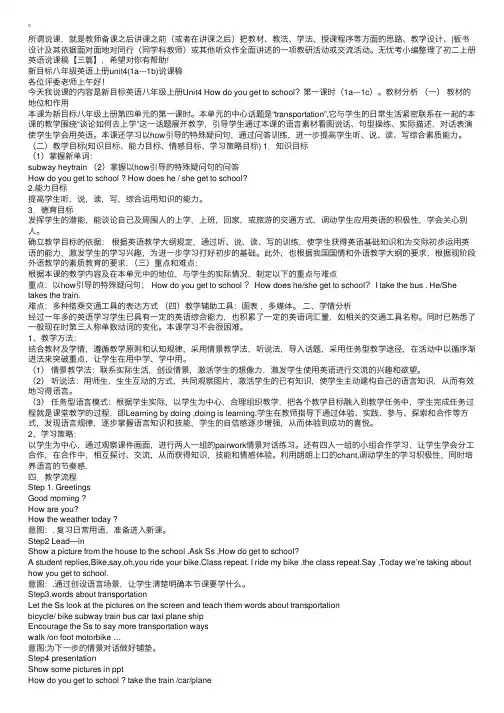
所谓说课,就是教师备课之后讲课之前(或者在讲课之后)把教材、教法、学法、授课程序等⽅⾯的思路、教学设计、|板书设计及其依据⾯对⾯地对同⾏(同学科教师)或其他听众作全⾯讲述的⼀项教研活动或交流活动。
⽆忧考⼩编整理了初⼆上册英语说课稿【三篇】,希望对你有帮助!新⽬标⼋年级英语上册unit4(1a---1b)说课稿各位评委⽼师上午好!今天我说课的内容是新⽬标英语⼋年级上册Unit4 How do you get to school?第⼀课时(1a---1c)。
教材分析(⼀)教材的地位和作⽤本课为新⽬标⼋年级上册第四单元的第⼀课时。
本单元的中⼼话题是“transportation”,它与学⽣的⽇常⽣活紧密联系在⼀起的本课的教学围绕“谈论如何去上学”这⼀话题展开教学,引导学⽣通过本课的语⾔素材看图说话、句型操练、实际描述,对话表演使学⽣学会⽤英语。
本课还学习以how引导的特殊疑问句,通过问答训练,进⼀步提⾼学⽣听、说、读、写综合素质能⼒。
(⼆)教学⽬标(知识⽬标、能⼒⽬标、情感⽬标、学习策略⽬标) 1.知识⽬标(1)掌握新单词:subway heytrain (2)掌握以how引导的特殊疑问句的问答How do you get to school ? How does he / she get to school?2.能⼒⽬标提⾼学⽣听,说,读,写,综合运⽤知识的能⼒。
3.德育⽬标发挥学⽣的潜能,能谈论⾃⼰及周围⼈的上学,上班,回家,或旅游的交通⽅式,调动学⽣应⽤英语的积极性,学会关⼼别⼈。
确⽴教学⽬标的依据:根据英语教学⼤纲规定,通过听、说、读、写的训练,使学⽣获得英语基础知识和为交际初步运⽤英语的能⼒,激发学⽣的学习兴趣,为进⼀步学习打好初步的基础。
此外,也根据我国国情和外语教学⼤纲的要求,根据现阶段外语教学的素质教育的要求. (三)重点和难点:根据本课的教学内容及在本单元中的地位,与学⽣的实际情况,制定以下的重点与难点重点:以how引导的特殊疑问句; How do you get to school ? How does he/she get to school? I take the bus . He/She takes the train.难点:多种搭乘交通⼯具的表达⽅式(四)教学辅助⼯具:图表,多媒体。
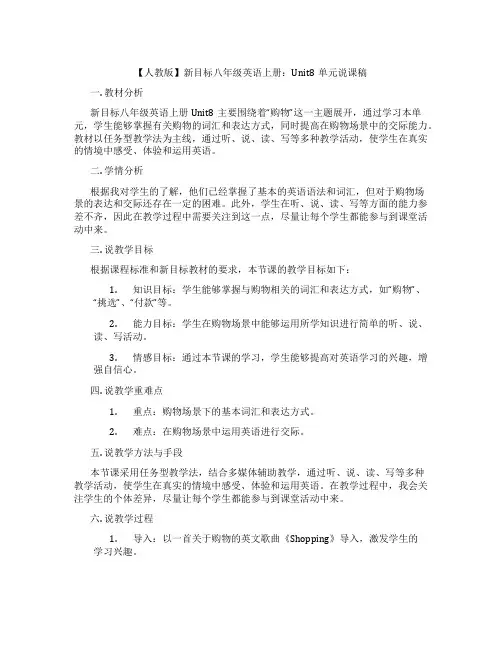
【人教版】新目标八年级英语上册:Unit8单元说课稿一. 教材分析新目标八年级英语上册Unit8主要围绕着“购物”这一主题展开,通过学习本单元,学生能够掌握有关购物的词汇和表达方式,同时提高在购物场景中的交际能力。
教材以任务型教学法为主线,通过听、说、读、写等多种教学活动,使学生在真实的情境中感受、体验和运用英语。
二. 学情分析根据我对学生的了解,他们已经掌握了基本的英语语法和词汇,但对于购物场景的表达和交际还存在一定的困难。
此外,学生在听、说、读、写等方面的能力参差不齐,因此在教学过程中需要关注到这一点,尽量让每个学生都能参与到课堂活动中来。
三. 说教学目标根据课程标准和新目标教材的要求,本节课的教学目标如下:1.知识目标:学生能够掌握与购物相关的词汇和表达方式,如“购物”、“挑选”、“付款”等。
2.能力目标:学生在购物场景中能够运用所学知识进行简单的听、说、读、写活动。
3.情感目标:通过本节课的学习,学生能够提高对英语学习的兴趣,增强自信心。
四. 说教学重难点1.重点:购物场景下的基本词汇和表达方式。
2.难点:在购物场景中运用英语进行交际。
五. 说教学方法与手段本节课采用任务型教学法,结合多媒体辅助教学,通过听、说、读、写等多种教学活动,使学生在真实的情境中感受、体验和运用英语。
在教学过程中,我会关注学生的个体差异,尽量让每个学生都能参与到课堂活动中来。
六. 说教学过程1.导入:以一首关于购物的英文歌曲《Shopping》导入,激发学生的学习兴趣。
2.新课呈现:通过展示一幅购物场景的图片,引出本节课的主题,并呈现相关词汇和表达方式。
3.课堂活动:a.分组进行角色扮演,模拟购物场景,练习交际用语。
b.完成一个购物小任务,如“购买一件衣服”,要求学生用英语进行交流。
c.学生展示自己的购物心得,分享购物经验。
4.巩固练习:通过完成一个购物问卷,检验学生对本节课知识的掌握程度。
5.总结:对本节课的内容进行归纳总结,提醒学生关注购物场景下的交际技巧。
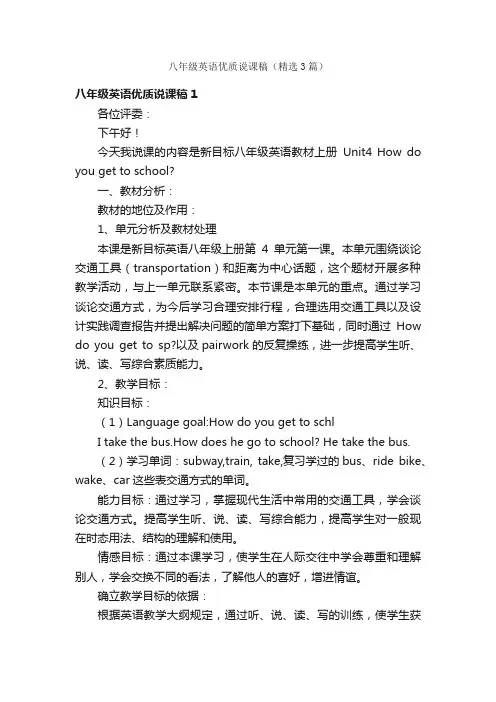
八年级英语优质说课稿(精选3篇)八年级英语优质说课稿1各位评委:下午好!今天我说课的内容是新目标八年级英语教材上册Unit4 How do you get to school?一、教材分析:教材的地位及作用:1、单元分析及教材处理本课是新目标英语八年级上册第4单元第一课。
本单元围绕谈论交通工具(transportation)和距离为中心话题,这个题材开展多种教学活动,与上一单元联系紧密。
本节课是本单元的重点。
通过学习谈论交通方式,为今后学习合理安排行程,合理选用交通工具以及设计实践调查报告并提出解决问题的简单方案打下基础,同时通过How do you get to sp?以及pairwork的反复操练,进一步提高学生听、说、读、写综合素质能力。
2、教学目标:知识目标:(1)Language goal:How do you get to schlI take the bus.How does he go to school? He take the bus.(2)学习单词:subway,train, take,复习学过的bus、ride bike、wake、car这些表交通方式的单词。
能力目标:通过学习,掌握现代生活中常用的交通工具,学会谈论交通方式。
提高学生听、说、读、写综合能力,提高学生对一般现在时态用法、结构的理解和使用。
情感目标:通过本课学习,使学生在人际交往中学会尊重和理解别人,学会交换不同的看法,了解他人的喜好,增进情谊。
确立教学目标的依据:根据英语教学大纲规定,通过听、说、读、写的训练,使学生获得英语基础知识和为交际初步运用英语的能力,激发学生的学习兴趣,为进一步学习打好初步的基础。
此外,也根据我国国情和外语教学大纲的要求,根据现阶段外语教学的素质教育的要求。
3、重点与难点:重点:掌握各种交通工具的名称,学会表述自己和谈论他人的交通方式。
句型:How引导的特殊疑问句难点:一般现在时态第一到第三人称表述词形的变化。
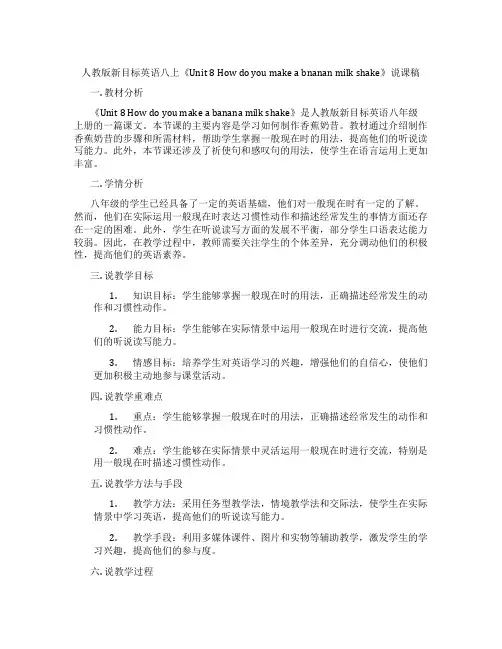
人教版新目标英语八上《Unit 8 How do you make a bnanan milk shake》说课稿一. 教材分析《Unit 8 How do you make a banana milk shake》是人教版新目标英语八年级上册的一篇课文。
本节课的主要内容是学习如何制作香蕉奶昔。
教材通过介绍制作香蕉奶昔的步骤和所需材料,帮助学生掌握一般现在时的用法,提高他们的听说读写能力。
此外,本节课还涉及了祈使句和感叹句的用法,使学生在语言运用上更加丰富。
二. 学情分析八年级的学生已经具备了一定的英语基础,他们对一般现在时有一定的了解。
然而,他们在实际运用一般现在时表达习惯性动作和描述经常发生的事情方面还存在一定的困难。
此外,学生在听说读写方面的发展不平衡,部分学生口语表达能力较弱。
因此,在教学过程中,教师需要关注学生的个体差异,充分调动他们的积极性,提高他们的英语素养。
三. 说教学目标1.知识目标:学生能够掌握一般现在时的用法,正确描述经常发生的动作和习惯性动作。
2.能力目标:学生能够在实际情景中运用一般现在时进行交流,提高他们的听说读写能力。
3.情感目标:培养学生对英语学习的兴趣,增强他们的自信心,使他们更加积极主动地参与课堂活动。
四. 说教学重难点1.重点:学生能够掌握一般现在时的用法,正确描述经常发生的动作和习惯性动作。
2.难点:学生能够在实际情景中灵活运用一般现在时进行交流,特别是用一般现在时描述习惯性动作。
五. 说教学方法与手段1.教学方法:采用任务型教学法,情境教学法和交际法,使学生在实际情景中学习英语,提高他们的听说读写能力。
2.教学手段:利用多媒体课件、图片和实物等辅助教学,激发学生的学习兴趣,提高他们的参与度。
六. 说教学过程1.导入:教师通过提问引导学生谈论他们喜欢的饮料,引出本节课的主题——制作香蕉奶昔。
2.新课呈现:教师展示香蕉奶昔的制作过程,引导学生观察和描述每个步骤。
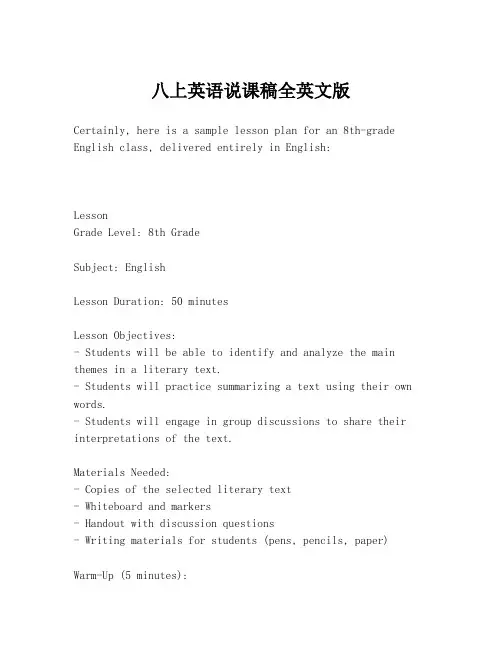
八上英语说课稿全英文版Certainly, here is a sample lesson plan for an 8th-grade English class, delivered entirely in English:LessonGrade Level: 8th GradeSubject: EnglishLesson Duration: 50 minutesLesson Objectives:- Students will be able to identify and analyze the main themes in a literary text.- Students will practice summarizing a text using their own words.- Students will engage in group discussions to share their interpretations of the text.Materials Needed:- Copies of the selected literary text- Whiteboard and markers- Handout with discussion questions- Writing materials for students (pens, pencils, paper) Warm-Up (5 minutes):Begin the class with a quick icebreaker activity. Have students share their favorite book and why they enjoy it. This will set the stage for our exploration of literature.Direct Instruction (15 minutes):Introduce the concept of themes in literature. Use the whiteboard to define 'theme' and provide examples from well-known stories. Explain that themes are the underlying messages or lessons that authors want readers to understand.Guided Practice (15 minutes):Distribute the selected literary text to the students. Have them read the text silently, and then guide them through identifying the main theme(s) of the story. Model how to summarize the text in their own words, emphasizing the importance of paraphrasing rather than copying.Independent Practice (10 minutes):Allow students to work individually to write a brief summary of the text, focusing on the main theme. Encourage them to use evidence from the text to support their summaries.Group Work (5 minutes):Organize students into small groups. Distribute the handout with discussion questions related to the text's theme and their summaries. Have them discuss their interpretations and share insights with each other.Closure (5 minutes):Conclude the lesson by bringing the class together for a whole-group discussion. Ask each group to share one keyinsight from their discussion. Summarize the main points and encourage students to reflect on how understanding themes can deepen their appreciation of literature.Assessment:- Participation in group discussions- Quality of individual text summaries- Completion of handout discussion questionsDifferentiation:- Provide additional support to struggling students by offering sentence starters for their summaries.- Challenge advanced students to identify secondary themes and support their findings with textual evidence.Homework:- Read a short story of their choice and write a one-page analysis of its main theme.This lesson plan is designed to be interactive and engaging, encouraging students to actively participate in the learning process and develop a deeper understanding of literature.。

人教新目标版八年级上册Unit2 How often do you exercise第一课时全英文说课稿Good morning everyone, I’m XX. It’s my great pleasure to get your attention. The lesson plan I am going to present is from Go for it Great 8 Section A of Unit 2 How often do you exercise? Period 1, and I will present my teaching plan from the following 5 parts.( 1. Analysis the teaching material 2.Teaching methods 3.Studying ways 4.Teaching procedures 5. Blackboard designing)Part 1 Analysis the teaching material I will also present this part from 5 parts. 1.Status and functionThe topic of this unit is to talk about how often they do things. This is a useful expression. This topic is related to Ss’daily life. All the activities of this class are helpful to raise Ss’ learning interest. At the same time, the target language of this class is the basis for Ss to learn other contents of this unit, so it’s very important for Ss to learn this class well.2.Analysis the SsAs we know, the Ss of Great 8 have learned English before, so they can use some words and simple sentences to express their ideas. And this topic of this class is close to Ss’ daily life, they will be very interested in this class. Moreover, the junior school Ss ‘abstract thinking is relatively low and their attention can’t last for a long time. But they enjoy showing themselves in class.3.Teaching aims and demandsThe teaching aims basis is established according to the junior school English syllabus provision, and I set the following objects:1.Knowledge objects: To enable the Ss master the key vocabularies and phrases: housework, How often, hardly everTo make the Ss understand and use the target language: How often do you do sth.? I often.What do you usually do on weekends?To let Ss master the Adverb of frequency2. Ability objects: To develop the Ss’abilities of listening, speaking, reading and writing,To train the Ss’abilities of shorthand, communicating, thinking and summarizing.3.Moral objects: To make the Ss learn how to work with others and express ideas during the communicatingTo make the Ss have the feeling of successful and achievement.4.Teaching key and difficult points:To make the Ss express the daily activities with the target language and adverbs of frequency.5.Teaching aids:In this class, I mainly use: multi-media computer, tape recorder, music, flashing cards,school things and so on. They will be needed in this class.Part2 Teaching methods:In this class, I mainly use: Communicative teaching method; task-based teaching method; game teaching method; cooperative teaching method ”As we know, the main instructional aims of Ss in junior school is to cultivate their abilities of listening ,speaking, reading, writing and their good sense of English language. So I will use these methods, That’s to say, I will let the Ss have a better understanding of target language. I will give the Ss some tasks and arrange some activities to have my class.Part3 Studying waysIn this class, to make the Ss master the key vocabularies and phrases by guessing, acting, listening and using.To make the Ss learn the English language by communicating, using, and listeningTo enable the Ss master the target language by summarizing, using and doing some exercises.Some Ss are lack of courage and independent thinking ability, So I will be a guider, Many activities require all the Ss to take part in , they will have many chances to practice their English. They will do some pairwork or groupwork to learn how ro communicate and exchange information with others.Part4.Teaching procedures Let’s focus on the teaching procedures which include 7 steps.Step 1. Warming up ( 2 minutes )Enjoy a English song“Where are you going?”The purpose of my designing : to attract the Ss’attention and form the relaxing learning surrounding, Stimulate the Ss’ learning interest and let them be ready for the class.Step2:Revision Free talkingT: Did you have a good summer vacation? S: Yes, of course.T: What did you do in your summer vacation. S: I went swimming.The purpose of my designing: To make the Ss feel easy at the beginning, and they review the phrasal verbs they have learned before. Also this part is helpful to learn the new lesson.Step3:presentation1.T:Well, you all did so many things in you summer vacation. How about your weekends? What do you usually do on weekends?I usually do some reading on weekend. How about you, boys and girls?S: I often watch TV on weekend.T: Very good. Others ?(Teacher will ask and Ss answer what they do again and again until the Ss understand and use them well)2.Teacher provides some pictures on the screen and ask “What does he/she do on weekends?”and the Ss answer them according to the pictures.The purpose of my designing :To consolidate the target language and the pictures can stimulate Ss’ learning interest. It also develop the Ss’ listening and speaking skills.3.T:Well, I usually exercise in my free time. Do you like exercising? Do you usually exercise in you free time? S: Yes.T: I think health is the most important thing in my life, so I exercise three times in a week.How many times do you exercise in a week? S: Once.Present the sentences pattern : How often do you do sth.?And adverbs of frequency: always, usually, often, sometimes, hardly ever,never and once/ twice/ three times a week/ a monthThe purpose of my designing:To make the Ss master the new words quickly and correctly, at this moment, I give the Ss the sentence pattern.Step4: Practice (pair work)T: Now, boys and girls. Work in pairs and talk about what you usually do in your free time and how often you do it. The purpose of my designing:This activity provides Ss a good chance to use English freely. It not only helps the Ss master the target language but also can help them learn from each other. It will train Ss’ listening, speaking skills and improve their ability of working with others.Step5 ListeningThe teacher input more target language including words and sentences by listening to the tapes. Ss listen to 1b and then check the answers. Then Ss listen to 1b again and repeat. Let the Ss listen and imitate the conversation, pay attention to their pronunciation and intonation.The purpose of my designing:This step can develop their listening skills and consolidate the target language.Step6 WritingIn this step, teacher will ask the Ss to do a survey in their group about how often they do things, and then write a short report , show it in class them.The purpose of my designing:This activity provides Ss a good chance to use English freely. They can finish the survey and writing according to their thoughts byusing the target language.At the same time, It trains their speaking, writing skills. Step7 Summary and HomeworkThe purpose of my designing: I think Ss should master the knowledge in class, so I’ll give Ss 1or 2 minutes to summary. If they have questions, I will help them solve. Also homework is so important that the Ss should speak English as much as they can in class or after class. It’s necessary for Ss to do some extensive exercises after class to consolidate the knowledge they learned.Part5 Blackboard designing。
新目标英语八年级上Unit 1 Section A说课稿新目标英语八年级上Unit 1 H ften d u exeriseSetin A说教案1a ---1教材分析:本单元以“H ften d u exerise ?”为话题展开教学活动。
首先学会恰当地使用频率副词及短语,再学会描述余时间的活动安排和基本饮食结构。
通过复习七年级学习过的动词短语,及本单元的听力练习,各种方式的口语交际活动和写作练习,使学生积极参与,合作,从而培养学生的综合语言运用能力。
教材在本单元的开篇,即本时,安排了关于谈论余时间的各项活动,以及初步认识和使用频率副词,为进一步地使用频率副词及动词短语做语言知识上的准备。
教学目标:A:语言目标:恰当使用alas usuall ften seties hardl ever never 等频率副词和日常活动短语:ath TV g shpping read bs exerise等。
掌握句型:hat d u usuall d n eeends? I ften g t the vieshat des she d n eeends ?She ften ges t the viesB:能力目标:学习描述余时间的活动安排,初步培养学生的语言综合运用能力。
:德育目标:培养学生的逻辑表述能力,激发学生的积极思维,并使学生互相了解,增进友谊,加强人际交往,以形成良好的人际关系。
教学重点:核心句型:hat d u usuall d n eeends?I ften g t the vies教学难点:第三人称单数谓语动词在此核心句型中的运用。
教学用具:词汇卡片多媒体一套教学过程:Step1 ar-up ativities(1) D it (学生按教师的指令做动作)T:Read bs / D her!/ Dra pitures/ L at the blabardT: run / stp / stand up / sit dn(2) D as I d(学生跟老师边说边做动作)I read bs n eeendsI run n eeendsI d her n eeendsStep 2 Revisin and presentatin(1)教师问:“hat d u usuall d n eeends ? ” (并且板书)让学生根据自己的实际回答I usuall …… n eeends(2)教师出示动词卡片ath TV、read bs 、exerise 、lean、satebard、pla basetball、ash lthes、g shpping、g t vies让学生认读。
新目标英语八年级上册Unit 10 Section A Period1(Go for it 2A)说课稿一.说教材1.教材的地位与作用:Unit10 I’m going to be a basketball player. 这单元通过复习和学习一些关于职业的词汇,用be going to谈论长大以后打算做什么以及打算怎样实现目标,与七年级(下)Unit 4 I want to be an actor. 学习关于职业的词汇以及用want to be\do谈论将来,和八年级(上)Unit 3 What are you doing for vacation? 用be doing谈论将来的打算有着密切的联系。
本课是这单元的第一课和重点课,学好本课将为进一步学习一般将来时打下良好的基础。
2.教学目标:(1).知识目标:掌握本课重点词汇computer programmer, computer science, engineer, pilot, professional ….本课主要句型:What are you going to be when you grow up? I’m going to be an e ngineer. How are you going to do that? I’m going to study math hard. 语法:用be going to表示一般将来时。
(2).能力目标:培养学生应用英语谈论将来计划,提高学生听、说、读、写等能力。
(3).情感目标:通过谈论将来打算做什么以及准备怎样实现目标,让学生考虑自己的将来,及早为将来做好准备。
培养学生学习英语的强烈兴趣,乐于参加各种活动的积极情感,善于合作,培养学生团结协作精神。
(4).教学重、难点:重点是掌握本课 computer programmer, computer science, engineer, pilot, professional等重点词汇,What are you going to be when you grow up? I’m going to be an engineer. How are you going to do that? I’m going to study math hard.等重点句型和语法:用be going to表示一般将来时。
【关键字】学习今天我说课的题目是新目标英语八年级上UNIT 10 I'm going to be a basketball player-Section A(3a) .本课位于人教版八年级上第10 单元的第一部分。
主要是通过学习动词的一般将来时态,讨论人生理想和将来打算、计划。
目的是通过对人生理想的讨论使青少年在这个如花的季节不仅对未来有美好的憧憬,而且要从现在做起,为健康的理想而奋斗。
一、说教材1. 教材地位本单元从时态上是一般将来时,是继一般过去时之后的又一重要时态;从话题上看是谈论未来的打算,是让学生从小就树立自己的人生理想,本单元通过复习一些旧的职业名词和学习一些新的职业词汇,使用be going to谈论长大以后打算做什么工作以及打算怎样实现目标。
2. 教学目标(1).知识目标: 要求学生掌握关于职业的名词computer programmer, computer science, engineer , professional ….本课主要句型:What are you going to be when you grow up? I'm going to be an actress. How are you going to do that? I'm going to take acting lessons.语法:用be going to表示一般将来时。
(2).能力目标:能听懂有关人生理想的词汇及表达;能听懂有关未来计划的表达;能进行有关人生的谈话;能进行有关将来计划的讨论。
培养学生应用英语谈论将来计划,提高学生听、说、读、写等能力。
(3)情感目标:通过对人生理想的讨论,让学生从小就树立自己的人生理想,并且现在就下决心,为理想而努力奋斗。
使他们成为有理想,有抱负,有动力,健康成长的新一代青少年。
3. 教学重点、难点。
(1)重点词汇:要求学生掌握关于职业的名词computer programmer, computer science, engin eer, professional ….(2)重点句型:本节课要求学生掌握并能够正确运用:What are you going to be when you grow up? I'm going to be an actress. How are you going to do that? I'm going to take acting lessons.(2)难点:一般将来时be going to 中be 的具体形式和后面接动词原形的用法学生容易混淆. 学生根据自己喜欢的职业,运用所学知识谈论自己打算怎样做来实现目标则既是难点,又是能力训练点。
人教新目标八年级上册英语全册说课稿备课人:UNIT 1 Where did you go on vacation? 说课稿(模板一)一.说教材1.本单元所谈论的话题是where did you go on vacation? 这个单元我们所涉及到的时态是一般过去时态,可以说是以上一单元的扩展,本单元出现了更多样的句型,例如:where did …? what did…? Did you…? How was/were…?尽管这些句型掌握起来有些难度,但将其置于同学们所熟悉所喜欢的谈论假日生活的话题中,便可激发学生表达的欲望,从而使学生感兴趣进而掌握。
2.本单元共分5-6课时,本课时是第3课时,section B 是整个单元的重心。
是对sectionA所讲知识的归纳拓展,例如形容词的拓展。
同时还涉及到了对学生听说读写四项基本语言技能的培养,使其语言运用综合化,使零散的语言整体化。
写的技能虽在本课时中未做体现,但本课所学句型结构、词汇都是为这个主题服务,做铺垫的。
二.说目标本课时的重点就是通过听力材料所引出的句型“where did…?what did…? Did you…? How was/were…?”以及3a中日记的复述。
日记的写作及关键句型将在下一课时中详细讲解。
总体来说,学生对句型均已熟练掌握,基本上达到了预期目标。
三.说教法在我的每堂课的教学中基本上都体现了“巩固前面所学知识――拓展新知识点――为重点难点教学打基础”这三步曲,在每进行一步基本都与学生互动、调动学生积极性的活动,如引课出的“brainstorm”,讲解单词中的让学生当堂记忆,听力材料中的编制小对话以及日记部分的给出关键复述课文。
使学生成为课堂教学每个环节的主体。
四. 说教学过程1.教具学具本身就是教师为提高课堂教学效果而选取的辅助工具。
而由于本课时容量较大,本身课本安排较新颖,具有很强的实用性,插图配置也很合时合时,因此本课时除了听力的导入展现了几幅图外没有新增图片。
新目标英语八年级上全英文说课稿Unit4 How do you get to school?Good morning, everyone! I am *** from Experimental Middle School of ***. Now I’ll say section A (from 1a to2d) of Unit4.It’s from Grade8(I) in Go For It! The title is “How do you get to school?”.I’ll say the lesson from four p arts: 一、Analysis of teaching material 二、Teaching methods 三、Guide of st udying ways 四、Teaching precedure.一: Analysis of the teaching material(一) Status and function1. The main topic of Unit 4 is “transportation”. In this unit, the Ss wi ll learn to talk about kinds of transportation, how long it takes to go places, and how far apart places are. This is a topic that is related to their daily life. So it can raise their learning interests and improve their spoken English.(二) Teaching aims and demands1. Knowledge ObjectsIn this lesson, Ss should master the new words “take, subway, train, forty…” etc. At the same time, they should know how to use these sentences “How do you get to school? How does he get to school? How long does it ta ke?”and know how to answer these questions.2. Abillity ObjectsIn this lesson, I’ll mainly train the Ss listening and speaking abilities and deve lop the Ss’ abilities of communication by learning the useful structures.3. Moral ObjectsIn this lesson, the Ss should learn how to work with others and help each oth er, how to impress their own ideas during the communication.4.Teaching keys and difficultiesAccording to the teaching aims, I think the focus of this lesson is the new ex pressions and help the Ss to communicate with each other. The difficulty is to distinguish the use of “take”.二、Teaching methodsIn this lesson, I’ll mainly use the “task-based” teaching method, and it will be used in the whole lesson. I think it’s helpful to develop the Ss’ thought. I’llalso use “situation communicating” method. It can provide enough listening a n d speaking situations for Ss. I think good teaching methods are the keys to su ccess三、Guide of studying waysIn order to guide the Ss better, develop the Ss’ abillities, in this lesson, the S s will learn how to be a good language learner , and how to communicate wit h others. It will be very helpful for their learning in the future. I think good s tudying ways can help the Ss to be good language learners.四、Teaching procedure1. Warm-upIn order to form a better English surrounding for Ss, attract the Ss’ at tention, I’ll begin my class with an English song—The number song. It can also help the Ss finish the teaching task of Part2a and 2b more easily. I think a good b eginning is a half of success.2. PresentationLet the Ss look at the picture .Ask: What is the boy doing? Where is he going ? How does he get to school? Help the Ss answer: He often rides a bike to school. (He often goes to school by bike.)Then use these pictures to teach other transportations “take the subway, take th e train…” After that , I’ll ask the students to make dialogues like this :A:How do you get to school?B:I get to school by bus.A:How does he get to school?B:He gets to school by train.Encourage them to use different words and find out the best group.This activity can not only help the Ss grasp the usage of target language, but also can help the Ss learn from each other. It can not only improve the Ss’ s peaking and listening skills, but aslo improve their ability of working with oth ers. The Ss at this age enjoy showing themselves, so it can also improve theirstudying interests, I think it’s most important during studying, because interest is a best teacher.3. Listening practiceAsk the Ss finish 1b. I think it’s easy for them to do it after Part 2. In order to improve their reading ability, I will ask them to read the dialogue , because listening is insparable from reading.4. DiscussionTell the Ss: The transportation we choose mainly depends on how far the plac es are, different distances, we’ll choose different transportations,and different tra nsportations ,It will take different time.Then let the Ss look at the list, ask them to discuss : “How do they get to s chool?”Finally, ask the Ss to practice in pairs like this:A:Har far is from Wang Min’s home to his school?B:It’s 500 metersA:How does he get to school?B:He gets to school on foot.A:How long does it take?B:It takes 5 This activity can help them learn to work together with others and can improv e their speaking skills. The most important thing is that it can improve the Ss’ability of solving problems, it’s a kind of important ability for both their dail y life and future life.5. Listening practiceIn Part Four, Ss have understood different ways of transportation takes differen t time. In this step, I’ll ask the Ss to name the five ways of transportation fir st. It can help them finish it more easily. Then play the tape, while the Ss lis tening , I’ll go around the classroom and help the Ss who have trouble in list ening . It can not only help the Ss who have trouble in listening, but also help the teachers go closer to the Ss. I think the closer the teachers go to the Ss , the better the students will learn.亲其师,信其道。